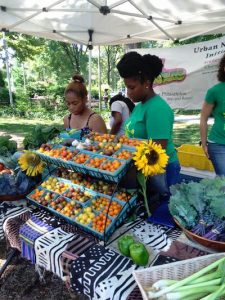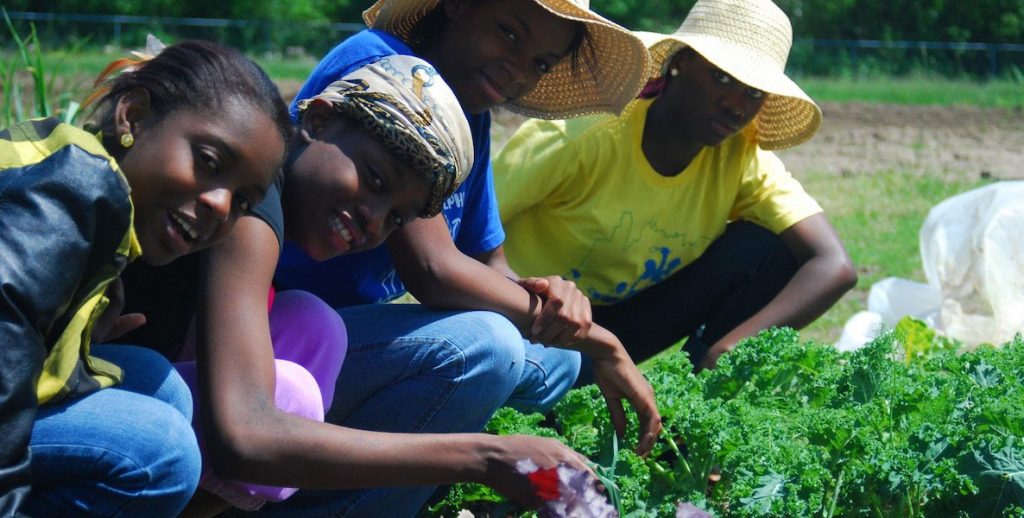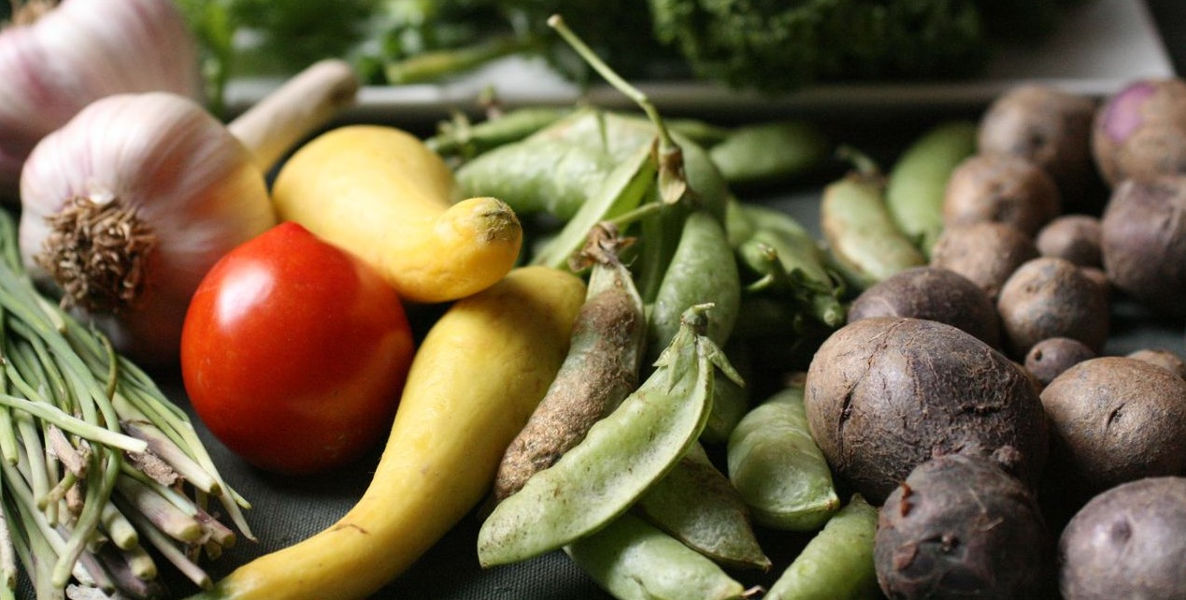The Fresh Grocer at 40th and Walnut streets, on Penn’s campus, is a sleek glass-fronted building that regularly stocks blood oranges and wasabi peas, and is just one of several choices for nearby residents. In contrast, the Fresh Grocer at 54th and Chester is a beige block set back from the sidewalk by asphalt parking lots and the only choice for miles besides bodegas. Inside, recently, it offered several expired packages of lunch meat and a fruit selection little beyond apples or bananas.
According to recent studies, great swaths of Philadelphia are “food deserts” like this—areas where residents live far from supermarkets that stock healthy foods, and can often not afford expensive produce even if they get there. Southwest Philadelphia—roughly west of the Schuylkill River, east of Cobbs Creek Park and south of Baltimore Avenue—is home to approximately one-fifth of Philadelphia’s food-deserted residents.
So why not grow the healthy food themselves? This is the ethos behind the Community Farm and Food Resource Center (CFFRC), a thriving farm and nutritional education center located on four acres of Bartram’s Garden, a National Historic Landmark in Southwest Philadelphia. A project of the Agaston Urban Nutrition Initiative (AUNI) at the University of Pennsylvania, the farm is home to 1.5 acres of vegetables, 130 trees, a 60-bed community garden (open to any nearby resident, including those in the Bartram Village public housing complex), a kitchen classroom and a solar heated greenhouse.
“We’re providing a space for people to be connected to their food,” says Ty Holmberg, co-director of the CFFRC, who helped start the program four years ago. “Having a relationship with food has big ripples outward, affecting the overall health and well being of this community.”
The seed of the program was planted when Holmberg, a longtime staffer for Agaston, fell in love with Bartram’s Garden. During a retreat there in 2010, he saw a swath of open meadow that overlooked the city of Philadelphia. It seemed like the perfect spot for growing food. AUNI already offered programs to teach Philadelphians about food, and get better access to it, and had created several small gardens at schools and community centers. But it lacked a central hub for farming production.
“Growing our own food lets us be independent of the people in power who determine where a grocery store goes and what it sells,” says Holmberg. “We are relying on the strengths of our own community to keep us healthy and empowered.”
Holmberg still had the image of a Bartram’s farm in his mind when he went to Boston for a conference at The Food Project, which farms 70 acres in and around that city. He came back invigorated, and with the support of Agaston’s leadership, approached Bartram’s Garden about making urban farming in southwest Philadelphia a reality. (The farm is funded through a partnership with the Pennsylvania Horticulture Society, Bartram’s Garden and the City of Philadelphia.)
The power that runs the Bartram farm doesn’t come from expert farmers, though. It comes from high school students. For more than eight years, Agaston, a program of Penn’s Netter Center for Community Partnerships, has provided nutrition and food justice classes at high schools throughout West and Southwest Philadelphia. In turn, those young people have become agents of change in their communities by becoming nutrition and wellness mentors to younger students, other teens and even their parents.

Agaston favors this approach for two reasons. First, it has proven to be effective—teenagers have built-in connections with their community and are better positioned to spread the word about healthy eating to their neighbors than is a professional outsider. And second, it is rooted in bottom-up grassroots change rather than what Holmberg describes as top-down “food evangelism”—well-intentioned white outsiders coming into a community of color with particular ideas about what makes good food and nutrition. The Bartram farm is this idea implemented on a larger scale than ever before in Philadelphia.
Specifically, the farm is run by students from nearby John Bartram High School, which has struggled to provide its students with a safe and high quality education for the last several years. High-achieving students are identified by teachers and invited to apply for the competitive internship program, which combines paid work on the farm, tutoring and academic support, and community volunteering. Holmberg says he and the other program director, Chris Bolden-Newsome, end up taking a mix of students who are “all-stars” and students who “might be harder to work with, but for whom this could be really impactful in their lives.”
Stop by Bartram’s on any Tuesday or Thursday afternoon, and you’ll find between 12 and 20 of these young people moving soil, planting, mulching, or harvesting crops like onions and collard greens. “You plant a seed and three weeks later it grows,” says Elizabeth, a senior intern. “It’s so cool. I grew that.”
The fruits of their labor are impressive. In 2015, with the help of 22 paid student interns, the farm produced over 12,000 pounds of food; worked with 45 local families in the community garden (including several from Bartram Village); distributed over 80,000 vegetable transplants through the Philadelphia Horticulture Society’s City Harvest program to over 130 farms and gardens around the city; hosted over 1,500 volunteers; and held 50 affordable weekly farm stands.
In 2015, the farm produced over 12,000 pounds of food; worked with 45 local families in the community garden; distributed over 80,000 vegetable transplants to over 130 farms and gardens; hosted over 1,500 volunteers; and held 50 affordable weekly farm stands.
For their time working on the farm—eight hours a week during the school year and 20 hours a week in the summer—high school interns are paid $7.25 an hour and attend classes on a wide range of food-related topics. Taught by Bolden-Newsome, an African American man who was raised in a black farming community in Mississippi, the classes delve into recipes, the basics of nutrition, how to use spices, where food comes from, and how class and race overlap with food justice. Bolden-Newsome also established a “diaspora garden” with the students so that they could learn about the ways foods have traveled throughout the world, and about culturally African foods.
The farm taps into a small but growing movement to bring farming back into black communities after generations of well-documented discrimination, violence and migration that nearly decimated African American farming—from around 926,000 black farmers in 1910 to 18,000 in 2000. That number is now slowly rising nationally. Food deserts, which can lead to higher levels of obesity and other diet-related diseases, such as diabetes and heart disease, according to the USDA, also disproportionately affect communities of color.
“The situation in Southwest Philadelphia is not an accident,” Holmberg says. “It is the result of a history of systems that have not supported or served these communities. Growing our own food lets us be independent of the people in power who determine where a grocery store goes and what it sells. We are relying on the strengths of our own community to keep us healthy and empowered.”
The Bartram interns staff the farmer’s market at 54th and Lindbergh every Thursday, teach nutrition classes to elementary and middle schoolers, and lead the volunteer days the farm holds on the second and fourth Saturdays of every month with as many as 150 citizens and Penn students. When these programs were first implemented, the community was reticent to respond. But the student interns led the way and soon others followed.
Farming, though, is not the end game for most of the students. The idea is “to use farming and connection to food as a medium for personal, academic, and professional growth.” The student interns get monthly teacher check-ins at their high school, an academic intervention plan if their grades fall below a C, and are required to attend college counseling classes and tutoring. Bartram farm seniors have a 100 percent graduation rate and all get accepted into at least one local college; the program has also had good success getting their students scholarships to four-year schools.
“We see young people selling to their neighbors, and reaching out to them as they come down for volunteer days,” says Holmberg. “Growing food—there’s something very human and magical about it.”
Photo Header: Community Farm at Bartram’s Garden


